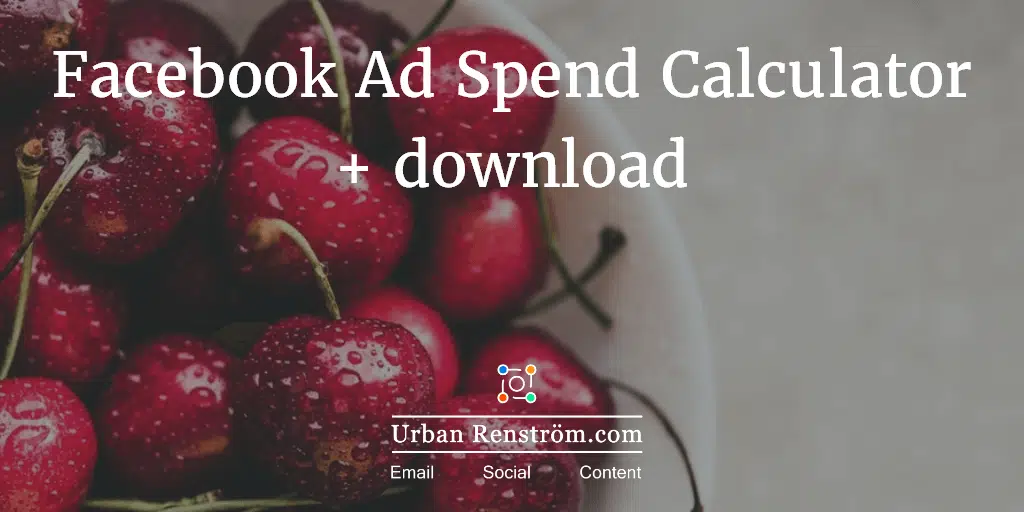Facebook Ads Spend Calculator + 1 Free download

How much should one budget for Facebook Ads is the most frequent question?
The next one is if €0.5 for ThuPlays is a lot, or if €0.95 per website click is big, or if €5 leads are too much, or how to cut CPM in half?
My answer is always always the same: don’t guess and focus on the metrics that matter to your business.
Scroll and see this Facebook Ads Spend Calculator is the sure-fire way to help determine those numbers.
UPDATED: Post updated February 2021, to reflect new understandings, check spelling and grammar, improve readability, adding cool calculators features and FREE download, and bring the post up to date.
Don’t worry, this is Urban Renström, there is always science and research involved in everything I do, discuss, and teach.
Skip Ahead ➡️ and Try the Facebook Ads Calculator 🧮
The top 10 Metrics that (should) Matter to your Business
These are business-level KPIs. So keep these in mind as you march through the Facebook ads spends calculator.
- Revenue
- Profit
- Cost of customer acquisition (CAC)
- Customer Lifetime Value
- The conversion rate of your sales page
- Cost of video ThruPlay
- Cost of Leads
- Number of leads
- Leads to Clients ratio
- Customer lifetime value (LTV)
- Client Churn
A few Basic Business Building Principles
*The cost to acquire new customers is always much much greater than keeping existing clients and selling more products and services to them. Think about the entire customer lifetime value cycle.
**Acquiring new clients is an investment in your business, not an expense.
***The Eisenhower principle is always in fashion
****Tools change but business fundamentals are a constant
First Things First – How Much to Budget for Facebook Ads?
Yea, budgeting is important. Also, is knowing the net worth of a new client (Lifetime Value!)? Therefore, flip the budget coin over and ask instead ‘what is the customer lifetime value of my existing clients. Then decide how much of that lifetime value you want to invest to acquire new clients.
Lifetime value is all the revenue minus expenses you get from a client during the lifetime they are a client.
Calculating Facebook Advertising Spend
Example: the *product* is a €99 financial budgeting video course helping aspiring homeowners learn how to budget and save for a mortgage to buy their dream home.
A simple conversion based funnel looks like the below image.
Let’s use our Facebook ads spend calculator on this simple funnel.
This funnel uses the conversion objective. And is an image advert to a cold audience with an offer..
The link in the advert takes people to a sales page. The red watch video button directs people to the shopping cart. Upon payment, the customer is directed to the video course and learn how to budget and save for a mortgage. Nothing tricky here. Thoughts and deeper explanation into the a-e bubble steps.
Begin at the End when making Facebook Ads Spend Calculation
Keep these questions and answers at hand. These are the end question you must answer.
Our goal at the end of this mental gymnastics is to see if you can achieve your campaign goals. Time to try out the Facebook ads spends calculator.
#KnowledgeisPower
THE Facebook Ads Spend Calculator
Use this Facebook ad spend calculator as a sandbox. A safe place to build quickly, erase and begin again. Adjust the number and see which has number has the largest leaver on the Facebook ad cost, the CPC, the Budget, Impressions, etc.
Below is the Explanation for each of the 15 *Boxes* in the Facebook Ads Spend Calculator
Sometimes Life, like this Calculator, Begs More Questions than it Answers!
*What if the CPA number is greater than the product cost?
yep, that does happen and one purchase is not the complete business story. Consider the customer lifetime value. If this €99 product is one of many to sell to people then maybe breakeven on this first product is ok…knowing that in a month or two they will buy a €299 product.
*What if my CPC is above €1 what do I do?
One metric out of context is not helpful. Sometimes during the year advertising costs go up, think BFCM.
*How do I lower my CPA?
Good question and not easily able to answer in the span of two sentences.
However, reverting back to the*conversion funnel* image of earlier. Advertising to a cold audience and expecting sales is the toughest sell ever. People don’t know you from anyone. Better is *warming up people* by putting an article between points *b* and *c*. E.g. “9 Secret Ways Future Homeowners can Save for a Down payment”. This article offers real and practical suggestions, the thing the ‘how-to’ of the problem. Then the CTA on that blog post is bought the video course the ‘what to do’.
Three big things this improves. 1) cost for the ad to the article is much lower than an ad for the product. 2) the conversion rate of people from Landing page to customer is much higher compared to an advert to a landing page. 3) You accelerate the know you, like you and trust you phases – so that people are more likely to trust you with their money!
*What Role Does Retargeting Adverts Play in the Facebook Ads Cost?
A big part. Custom audiences are the most powerful audiences on the Facebook ads ecosystem. Using our simple *Conversion funnel* from above. The three-place to use retargeting adverts are at point *b*, *c*, and *d*.
*b* If the creator of the advert was a video then you can retarget people who watch different lengths of the video but did not click through to the landing page. if using a static image then you cannot retarget people.
*c* very easy to retarget people that visited the landing page but did not take the desired actions – in this case, click the CTA and buy the course.
*d* retarget people who land on the shopping cart but don’t land on the thank you page.
NOTE when using the *conversion objective*: Facebook recommends ~50 *optimization events* (conversions) per week. If you will not get 50 sales/conversions per week then you must move your *optimization events* to a point higher in the funnel. Sales are at the bottom of the funnel.
For example, move the *optimization events* from the *receipt / TY* post-payment page to the Add to cart or the landing page (page views). Do this to get the 50 *optimization events* per week. Then and when you are confident of getting >50+ move the *optimization events* further down the funnel.
‘The Metrics that Matter‘ to your Business
Yet, when you open the Facebook Ads Manager and look, a tidal wave of metrics and numbers flood over your head and can easily drown you.
Facebook gives us 231 different metrics (yes, I counted) and these are the 11 important Facebook Ads Metrics you should monitor, and the 220 to ‘ignore’.
completion rate on most online courses
The completion rates range from 0.7% to 52.1%, with a median value of 12.6% see the MOOC Completion Rates research pdf.
Industry reports and instructional designers alike typically report that only between 5 to 15 percent of students who start free open online courses end up earning a certificate. From esurge.
Wizccabin quotes eLearning course completion rates at less than 15%.
A few happy, Thoughtful and thorough thoughts on this timely funnel
Download: THE Facebook Ads Calculator
The ONE Facebook Ads Spend Calculator to Rule Them All! 💍
No Spam. Includes email updates. One-click unsubscribes in every message. Privacy Policy.



Maybe I’m looking at this type of post. Thanks for explaining every part of ads cost. My starting time I used to free classified site (redacted) to promote my business. Now I’m in Paid
AndAds (and) this post will help me to keep on.Well done. As you know paid media is one element of your Paid, Earned, and Owned marketing mix.
Thanks for stopping by.
Hi thanks for sharing information about the calculation
You are most welcome.
What numbers are surprising?
Hi. I’m trying to create a calculator for myself in Airtable and I’m getting stuck on one part of the formula. Can I message you?
yep, work away…